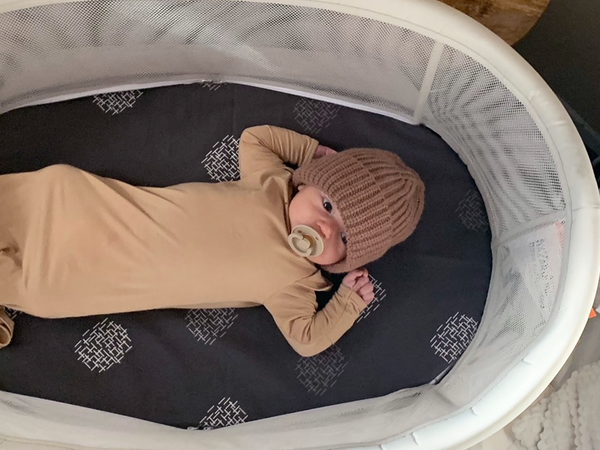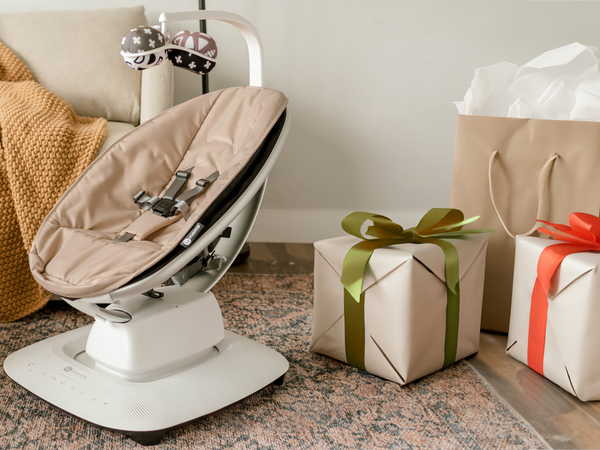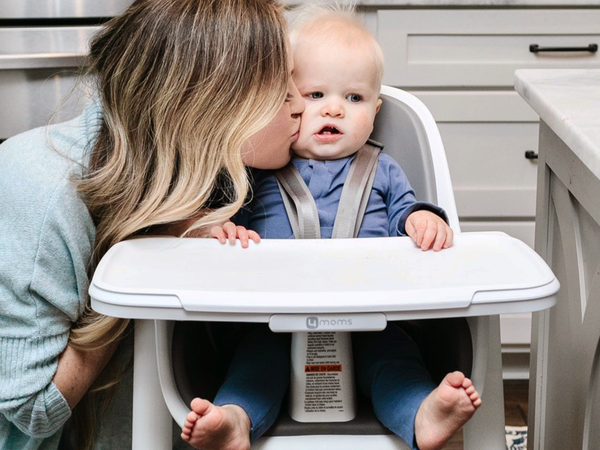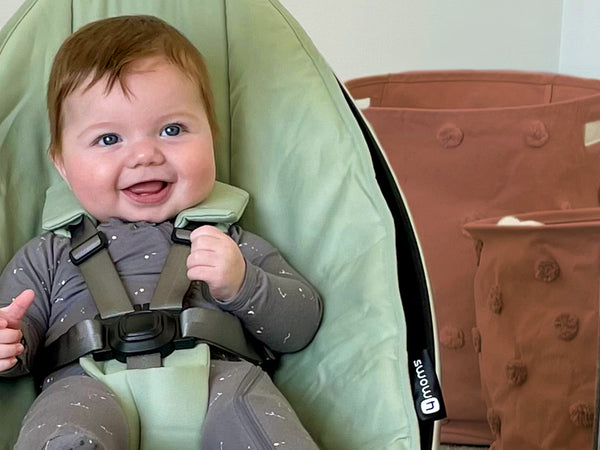Introducing Your Dog To A Newborn: Ultimate Guide
Turns out there is a right way to manage introducing your dog to a newborn that’s comfortable for your dog and safe for your baby. With careful planning and the right tools, it’s easy to create a safe and engaging space where your dog and your baby can coexist harmoniously.
In this guide to the best way to introduce your dog to your baby, we break it all down and explain how innovative products like 4moms rockers, swings, and playards can help you control interactions between your dog and your newborn.
Is It OK to Have Dogs Around Newborns?
Let’s start by dispelling a common myth about introducing a dog to a newborns. No, you won’t need to get rid of your dog when you bring your baby home. In fact, not only can your dog be a wonderful companion for your baby, research suggests that kids who grow up with dogs aren’t just happier, they have higher self esteem, are more compassionate, feel more emotionally supported, and are less stressed. Plus, exposure to dogs from an early age may reduce their risk of developing food allergies.
While it is safe to have your baby around your dog, you should be careful to take your dog’s temperament into account when introducing dogs to a baby. The changes can be overwhelming to your dog—new sounds, new smells, new schedules, and routines. They also may miss getting as much attention from you and may feel jealous of the time you spend with your baby.
To make the experience of your dog meeting your baby for the first time as easy as possible, lean on gear that keeps your baby content and secure so you can keep tabs on your dog and make sure they are reacting well to your baby’s presence. The MamaRoo® Multi-Motion Baby Swing®, for example, provides various motions and speeds and mimics your movements so you can keep the baby comfortable and safe while you’re caring for your dog. You can also use the Breeze® Go Playard as a safe, contained space for your baby to play or nap, ensuring they're secure when you need to focus on managing your dog's behavior.
Preparing Your Dog for Meeting Your Baby for the First Time
Don’t wait until your baby is home to help your dog adjust to the changes that come with a new family member. Preparation is key to introducing your dog to your baby, and we’ve put together a plan to help you every step of the way:
- First Trimester: If your dog isn’t already well trained, add signing up for obedience classes to your getting-ready-for-baby to-do list. And if your dog has never been around kids, seek out opportunities to expose your dog to children—in a controlled setting, of course—so they become accustomed to the noise and sudden movements of small children before introducing your dog to your newborn. You can also start training your dog if you plan to introduce new rules once the baby is here. For example, if you’ve always allowed your dog to jump on furniture but want the bed and couch to be off limits, start teaching them the new rule now instead of waiting until your baby is born. Lastly, remember that your dog will likely pick up on your changing hormones and your pheromones. According to the American Kennel Club (AKC), these changes may stress out your dog and make them anxious so practice staying calm and relaxed around them—deep breathing can help!
- Second Trimester: Now’s the time to familiarize your dog with some of the changes that lie ahead. If you know that your schedule will change when the baby arrives—maybe you’ll have to change the time of their morning walk to account for daycare drop off or start hitting the dog park on a different day—start slowly transitioning to that new schedule. Some experts suggest getting a lifelike doll that you can carry around and pretend to feed and change while your dog is in the room. You can also start getting your dog accustomed to baby sounds and movements, using the soothing sounds of 4moms products to get them acclimated to new noises in the household. For example, you can start up the MamaRoo® Multi-Motion Baby Swing® and let it swing back and forth so the novelty wears off and they’re used to the noise and movement of the swing once it's time to introduce your dog to your baby.
- Third Trimester: Use the final weeks before your baby’s birth to finalize your plans for how to introduce your dog to your baby. If the nursery is going to be off limits to your dog, practice having them “sit-stay” outside the doorway and keep the door to the room closed when you’re not around. If your dog will be allowed in the nursery, set up a dog bed in an out-of-the-way corner and teach them to settle on the bed on your command. If the dog has free rein in your living areas, you can set up the Breeze® Go Playard so you have a secure place to lay your baby down that the dog can’t get to.
- Postpartum: They say you only get one chance to make a first impression, and that is certainly true when it comes to your dog meeting baby for the first time. Ensure a smooth transition during the postpartum period by keeping your dog's routine as consistent as possible. Be sure to closely monitor how your dog reacts to and interacts with your baby, and never leave your baby unattended with your dog. And if your dog is active and needs lots of exercise, you may want to hire a dog walker or send them to doggie day care during those early days to burn off some energy.
When Can You Introduce a Dog to a Newborn?
You can introduce your dog to your baby right away, but taking a few steps to ensure their first encounter is a good one can pay off big time in the long run.
While you’re still in the hospital, send home a blanket or a onesie that smells like your baby and tuck it into your dog’s crate or dog bed so they recognize baby’s smell.
When you come home from the hospital, the ASPCA recommends waiting outside with the baby while your partner goes inside; this can give your dog the chance to greet your partner and wear off some of their energy. Then you can head inside to start the process of introducing your dog to your newborn for the first time in-person—but as a precaution, make sure your dog is leashed and restrained. Stay calm and relaxed even if you’re feeling jittery—your dog will pick up on your nervousness and may associate the baby with your negative feelings. Greet your dog in a soft and calm voice, praising them for any calm interest they take in the baby and taking care to avoid scolding them.
The best way to introduce a dog to a baby is to sit in a quiet room with the baby on your lap and invite the dog to approach. Let your dog sniff the baby’s feet for a couple of seconds, then gently interrupt their sniffing, praise them, and have them sit or lie down. Offer a reward or a toy and some more praise. Repeat the introduction a few times, gradually increasing the amount of time that your dog is allowed near the baby.
Keep a careful eye on your dog’s body language to make sure they’re relaxed and friendly during the entire time you're introducing your dog to baby. If you notice any signs of distress—growling, whining, tucked ears or tail, raised hackles, lip-licking, yawning, and panting—remove your dog from the room immediately.
How Long Does It Take for a Dog to Adjust to a Newborn?
Just like people, all dogs are different and it may take your dog some time to adjust to the new family dynamic. Some dogs will adapt to having a baby around the house in a few short days while others may need a few weeks. Just be patient and consistent with how you introduce your dog to your baby as your dog gets used to their new reality.
Above all else, keep a close eye on your dog whenever they are in the vicinity of the baby. As your dog gets more comfortable you can adjust the amount of time they spend with the baby. Be on the watch for signs of stress or jealousy in your dog and address them quickly and calmly. And, if necessary, don’t hesitate to seek out professional guidance to ensure a safe adjustment.
Living Together: Fostering a Bond Between Your Dog and Baby
Dogs are pack animals, so including your dog in baby-related activities is a great way to bond your family unit and continue the bonding beyond the moment when your dog is meeting baby for the first time. Relaxed walks with the baby in a stroller and the dog by your side can foster a sense of pack unity while you’re all having fun outside. (Don’t loop the leash onto the stroller handle though: If your dog suddenly bolts and jerks the leash it could be dangerous for the baby.) Be sure to use positive reinforcement, giving your dog treats and showering them with praise when they are calm and gentle. This helps your dog get used to the presence of the baby while reinforcing positive behavior.
You may also want to give your dog a designated safe space where they can relax and retreat, such as a crate, when they need a break from the baby. And remember, with patience, consistency, and positive reinforcement, your dog will be integrated into your family in no time.
Introducing Your Dog to Baby Lets You Become One Big Happy Family
Raising your child with a four-legged sibling is one of the best gifts you can give them—but it’s vital that you spend time physically and mentally preparing to create a safe and engaging environment for the baby. And 4moms is here to help every step of the way, with products that not only comfort your baby and keep them safe but also provide peace of mind for you as you’re navigating the new dynamics of family life.
Follow our safe and effective tips for introducing your dog to your newborn and before you know it, man’s best friend will be your baby’s best friend, too!
Disclaimer: Every dog and baby is unique and individual circumstances may vary. While every effort has been made to ensure the accuracy and reliability of the information in this blog post, it is for informational purposes only and should not be considered a substitute for professional advice or guidance. Consult with a qualified veterinarian or animal behaviorist for personalized recommendations and guidance specific to your pet and family situation.

















